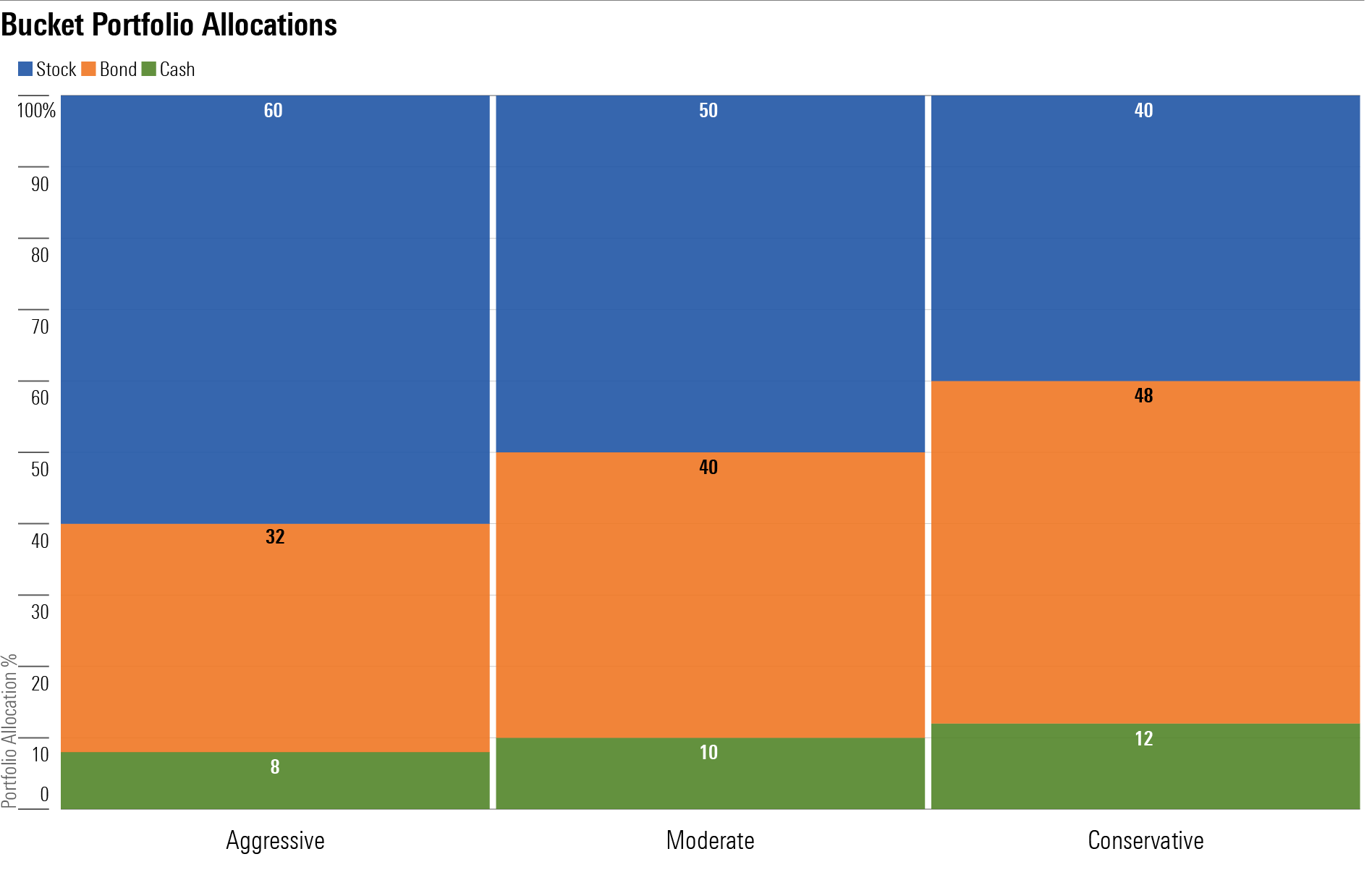Tax-Deferred Retirement-Bucket Portfolios for Mutual Fund Investors
These portfolio mixes are geared toward retirees with different time horizons and risk tolerances/capacities.

So much of investing during retirement comes down to the luck of the draw.
Prevailing interest rates could be high, enabling retirees to subsist exclusively on their stock and bond income. Or retirees could experience a period like 2005-20, when interest rates plummeted and even risky securities delivered miserly income payouts. Stock market values can also be unpredictable, as the recent past abundantly illustrates. People who embarked on retirement in 2010 enjoyed a nearly unbroken streak of gains from stocks for a decade, while those who hung it up in 2020 have had to put up with a lot more volatility, including substantial losses from stocks and bonds in 2022.
The Bucket approach to retirement portfolio allocation is designed to help retirees source their cash flows no matter what is going on with interest rates and stock and bond values. By maintaining an ongoing allocation to cash alongside a balanced portfolio, the retiree can withdraw funds from those liquid reserves when stock and/or bond values are in a trough. That allocation provides a psychological benefit, too, in that having cash on hand can help retirees cope with the volatility that will inevitably accompany their long-term holdings. In better market environments, retirees can source their cash flow needs from appreciated equity or bond holdings and not touch the cash.
About the Portfolios
These model portfolios are geared toward retired investors who are drawing upon their tax-deferred accounts to meet a portion of their living expenses. Bucket 1 of each portfolio is to provide money for cash needs for a year or two, so we’re not taking any risks with it; investors can use some combination of certificates of deposit, high-yield savings accounts, or money market mutual funds for this portion of the portfolio. Bucket 2 covers another eight years’ worth of cash flow needs. It’s designed to deliver slightly more income than Bucket 1, as well as a dash of inflation protection; thus, it consists mainly of high-quality short- and intermediate-term bonds. Bucket 3 is the growth engine of each of the portfolios, geared toward years 11 and beyond of retirement. Due to an anchor position in Vanguard Dividend Appreciation VDADX, which focuses on companies with a history of growing their dividends, the portfolio has a high-quality tilt that’s appropriate for a retirement portfolio.
The portfolios consist exclusively of funds that rate as Morningstar Medalists, meaning our analysts think they’re likely to outperform their peers over a full market cycle. I’ll make changes to the holdings only if their fundamentals change or they no longer rate as Medalists.
How to Use Them
Note that the goal of these portfolios isn’t to generate the best returns of any retirement portfolio on record, but rather to help retirees and pre-retirees visualize what a long-term, strategic total-return portfolio would look like. Thus, a newly retired investor could follow the basic Bucket concept without completely upending existing favorite holdings.
Investors should take care to customize their portfolios to suit their own situations—risk tolerance and capacity, of course, but also planned spending. An investor’s own cash bucket, and in turn the allocations to the other two buckets, will depend on their portfolio spending rate. If an investor is using a lower starting withdrawal rate—say, 3% in the first years of retirement—bucket 1 would accordingly be smaller (6% versus 8% in my Aggressive portfolio).

Aggressive Tax-Deferred Retirement-Bucket Portfolio for Mutual Fund Investors
Anticipated Time Horizon in Retirement: 25-plus years
Risk Tolerance/Capacity: High
Target Stock/Bond/Cash Mix: 60/32/8
Bucket 1: Years 1-2
- 8%: Cash (certificates of deposit, money market accounts, and so on)
Bucket 2: Years 3-10
- 8%: Fidelity Short-Term Bond FSHBX
- 7%: Vanguard Short-Term Inflation-Protected Securities VTAPX
- 10%: Harbor Core Plus HABDX
- 7%: Vanguard Wellesley Income VWIAX
Bucket 3: Years 11 and Beyond
- 25%: Vanguard Dividend Appreciation VDADX
- 15%: Vanguard Total Stock Market Index VTSAX
- 20%: American Funds International Growth and Income IGIFX
Moderate Tax-Deferred Retirement-Bucket Portfolio for Mutual Fund Investors
Anticipated Time Horizon in Retirement: 15-25 years
Risk Tolerance/Capacity: Moderate
Target Stock/Bond/Cash Mix: 50/40/10
Bucket 1: Years 1-2
- 10%: Cash
Bucket 2: Years 3-10
- 10%: Fidelity Short-Term Bond FSHBX
- 10%: Vanguard Short-Term Inflation-Protected Securities VTAPX
- 12%: Harbor Core Plus HABDX
- 5%: Vanguard Wellesley Income VWIAX
- 3%: Fidelity Floating Rate High Income FFRHX
Bucket 3: Years 11 and Beyond
- 25%: Vanguard Dividend Appreciation VDADX
- 10%: Vanguard Total Stock Market Index VTSAX
- 15%: American Funds International Growth and Income IGIFX
Conservative Tax-Deferred Retirement-Bucket Portfolio for Mutual Fund Investors
Anticipated Time Horizon in Retirement: Fewer than 15 years
Risk Tolerance/Capacity: Low
Target Stock/Bond/Cash Mix: 40/48/12
Bucket 1: Years 1-2
- 12%: Cash (certificates of deposit, money market accounts, and so on)
Bucket 2: Years 3-10
- 10%: Fidelity Short-Term Bond FSHBX
- 10%: Vanguard Short-Term Inflation-Protected Securities VTAPX
- 15%: Harbor Core Plus HABDX
- 5%: Vanguard Wellesley Income VWIAX
- 5%: Fidelity Floating Rate High Income FFRHX
- 3%: Loomis Sayles Bond LSBDX
Bucket 3: Years 11 and Beyond
The author or authors do not own shares in any securities mentioned in this article. Find out about Morningstar’s editorial policies.

/s3.amazonaws.com/arc-authors/morningstar/66112c3a-1edc-4f2a-ad8e-317f22d64dd3.jpg)
/cloudfront-us-east-1.images.arcpublishing.com/morningstar/CGEMAKSOGVCKBCSH32YM7X5FWI.png)
/cloudfront-us-east-1.images.arcpublishing.com/morningstar/LUIUEVKYO2PKAIBSSAUSBVZXHI.png)
:quality(80)/s3.amazonaws.com/arc-authors/morningstar/66112c3a-1edc-4f2a-ad8e-317f22d64dd3.jpg)